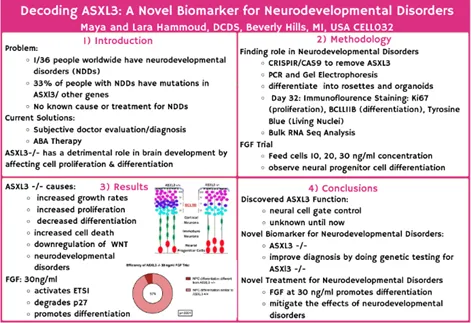Regeneron ISEF 2024 CELL First Award: Highlights and Analysis
In our previous article, we analyzed the winning projects in the Biomedical Engineering (ENBM) category in detail. Today, we will turn to the Cellular and Molecular Biology (CELL) category in the 2024 ISEF Global Finals and take a deep dive into how these outstanding research projects stood out from the fierce competition.
The Cellular and Molecular Biology (CELL) category in the Regeneron ISEF focuses on the study of cells at both the structural and functional levels. This interdisciplinary field involves understanding the complex processes and interactions within and between cells, including how they contribute to the overall function of an organism.
Projects in this category cover a variety of subfields, such as cell physiology, cellular immunology, genetics, molecular biology, and neurobiology. These studies aim to explore the cellular mechanisms and molecular pathways that underpin important biological processes and disease states. For example, cell physiology may study membrane transport or muscle contraction, while molecular biology can delve into the interactions between DNA, RNA, and protein synthesis. Genetics projects may focus on the structure and function of genes and their impact on health and disease, while neurobiology can study the cellular composition of the nervous system and its impact on behavior and cognitive function.
In this article, Embark’s experienced ISEF online tutors will conduct an in-depth analysis of the CELL first-place project. Although the analysis may not be perfect, our goal is to provide readers with more thinking angles and learning resources, hoping that everyone can gain inspiration from it and learn from each other.
Regeneron ISEF 2024 CELL First Award-Highlights
- Project Name
CELL032T - Decoding ASXL3

- Project Introduction
This project is dedicated to studying the role of the ASXL3 gene in neurodevelopmental disorders (NDD). By using CRISPR technology, we successfully constructed three H9 embryonic stem cell lines with different ASXL3 gene dosages, and used these cell lines to cultivate rosette structures and organoids.
The results showed that the loss of the ASXL3 gene accelerated cell growth and increased the proportion of proliferating cells, but reduced the differentiation of neurons, especially layer 5 cortical neurons. This discovery reveals the important role of ASXL3 in neuronal differentiation. In addition, we also found that treatment with a specific concentration of fibroblast growth factor (FGF) can effectively promote neuronal differentiation in ASXL3-deficient cells, which provides a new possible approach for the future treatment of NDD.
This project not only provides a new perspective for understanding the pathogenesis of NDD, but also lays the foundation for the development of therapeutic strategies for ASXL3 deficiency.
Regeneron ISEF 2024 CELL First Award-Analysis
This student research project mainly explores the relationship between neurodevelopmental disorders and the ASXL3 gene. Did you know that 33% of patients with neurodevelopmental disorders carry mutations in the ASXL3 gene, but how this gene specifically affects neurodevelopment is still an unknown area.
To figure this out, the students used CRISPR, the "magic scissors" of gene editing, to tamper with the ASXL3 gene in embryonic stem cells. They designed three plans: one was to keep the gene unchanged, one was to cut off part of the gene, and the other was to cut off the entire gene. Then, they quietly observed how these cells would differentiate and grow.
During the experiment, they focused on several important indicators: first, to confirm whether CRISPR really edited the cells as expected; then, to see whether these edited cells could normally differentiate into neural cells or brain organoids; then, they also checked the proliferation of cells and the differentiation of neurons; finally, they conducted a comparative analysis of the gene transcription level of cells that completely retained and completely cut off the ASXL3 gene.
They also used different concentrations of fibroblast growth factor to treat the cells whose ASXL3 gene was cut off to see if these cells could restore their differentiation ability. The highlight of this innovative ISEF project is that although the experimental design is not particularly complicated, it is very complete and forms a closed loop. This design makes the experimental conclusions very convincing and provides a new perspective for our understanding of neurodevelopmental disorders. Simply put, this project is trying to find the relationship between the ASXL3 gene and neurodevelopmental disorders, hoping to provide new ideas for future disease treatment.
About Embark
Embark was established in 2016 and is a background improvement education institution focusing on customized scientific research training for teenagers. If you want to explore the principles of gene editing in genetic research, then Embark, as an ISEF project customization platform, will help students to make steady progress in scientific research projects and achieve excellent results. Looking forward to you being the next one!
In the next article, we will continue to explore the award-winning projects in the Computational Biology and Bioinformatics (CBIO) category. CBIO combines biology, computer science and mathematics to provide new methods for understanding complex biological systems. This interdisciplinary integration promotes innovation and development in various fields. Please continue to learn with the analysis of Embark tutors!



